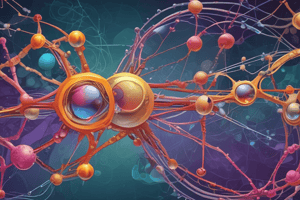Podcast
Questions and Answers
Where does prokaryotic transcription occur?
Where does prokaryotic transcription occur?
- Nucleus
- Cytoplasm (correct)
- Mitochondria
- Rough ER
What is recognized by RNA polymerase in prokaryotic transcription?
What is recognized by RNA polymerase in prokaryotic transcription?
- TATA box
- 5'cap
- -35 and -10 regions (correct)
- AUG codon
What is the role of the ribosome in prokaryotic translation?
What is the role of the ribosome in prokaryotic translation?
- Recognizes the 5'cap
- Adds poly A tail
- Recognizes SD box (correct)
- Recognizes the TATA box
Why can transcription and translation occur simultaneously in prokaryotic cells?
Why can transcription and translation occur simultaneously in prokaryotic cells?
What is the start codon for translation?
What is the start codon for translation?
All types of RNA have secondary structure.
All types of RNA have secondary structure.
What does the TATA box do in eukaryotic transcription?
What does the TATA box do in eukaryotic transcription?
Which RNA polymerase processes mRNA in eukaryotes?
Which RNA polymerase processes mRNA in eukaryotes?
What is unique about eukaryotic mRNA processing?
What is unique about eukaryotic mRNA processing?
What is the structural component of ribosomes?
What is the structural component of ribosomes?
Match the molecules with their complementary base pairing:
Match the molecules with their complementary base pairing:
The non-coding/template strand of DNA is also known as the ______ strand.
The non-coding/template strand of DNA is also known as the ______ strand.
Why is the central dogma not entirely correct?
Why is the central dogma not entirely correct?
Study Notes
Comparison of Prokaryotic and Eukaryotic Transcription
- Prokaryotic transcription occurs in the cytoplasm; eukaryotic transcription occurs in the nucleus.
- Prokaryotic RNA polymerase binds directly to -35 and -10 promoter regions; eukaryotic RNA polymerase requires transcription factors to bind to the TATA box.
- Prokaryotes lack promoter proximal and enhancer regions; eukaryotes utilize these regions for gene regulation.
- Shine-Dalgarno (SD) box present in prokaryotic mRNA; eukaryotic mRNA uses a 5' cap instead.
- Prokaryotic transcripts directly convert DNA to mature mRNA; eukaryotic pre-mRNA undergoes splicing and processing to become mRNA.
- Prokaryotic cells contain no introns or snRNPs; eukaryotic cells utilize alternative splicing mechanisms.
- Transcription termination in prokaryotes involves a hairpin loop; in eukaryotes, it occurs via a cleavage site recognized by RNase.
- Eukaryotic mRNA includes a 5' cap and poly A tail, while prokaryotic mRNA does not.
Comparison of Prokaryotic and Eukaryotic Translation
- Prokaryotic translation occurs in the cytoplasm simultaneously with transcription; eukaryotic translation happens in the cytoplasm, endoplasmic reticulum (ER), mitochondria, and chloroplasts after transcription is complete.
- Ribosomes in prokaryotes recognize the SD box for initiation; ribosomes in eukaryotes recognize the 5' cap and scan the 5' UTR for the start codon (AUG).
- Eukaryotic translation requires fully processed mature mRNA; prokaryotic translation can begin as mRNA is synthesized.
- There is no complementary base pairing between mRNA and rRNA in eukaryotic translation, unlike in prokaryotic translation.
Complementary Base Pairing of Molecules
- DNA pairs with itself, other DNA, mRNA, tRNA, rRNA, snRNA.
- mRNA interacts with itself, DNA, snRNA, rRNA, tRNA.
- rRNA pairs with itself, DNA, mRNA.
- tRNA pairs with itself, DNA, mRNA.
- snRNA pairs with itself, DNA, pre-mRNA.
- Proteins do not engage in complementary base pairing due to the absence of nucleotides.
Molecular Recognition in the Cell
- -10 and -35 regions are recognized as DNA by RNA polymerase.
- TATA box understood as DNA by transcription factors.
- Translation start and stop signals are recognized by tRNA and release factors.
- Terminator regions are recognized by RNA polymerase as part of mRNA.
- PolyA signal recognized as pre-mRNA by polyA polymerase.
- Cleavage sites in pre-mRNA are recognized by RNase proteins.
- Splice sites within introns recognized by snRNPs.
- Shine-Dalgarno (SD) box recognized by rRNA in mRNA.
Polyribosomes
- Visual representation of polyribosomes can be observed on a whiteboard (interaction and clustering of multiple ribosomes on a single mRNA strand).
Reasons for Simultaneous Transcription and Translation in Prokaryotes
- Prokaryotic cells can perform concurrent transcription and translation due to the absence of pre-mRNA processing, allowing immediate translation.
Central Dogma of Molecular Biology
- The central dogma states DNA is transcribed to RNA, which is translated to protein.
- Not all RNA types are translated into proteins; only coding RNA (mRNA) is translated, while non-coding RNAs (ncRNA) function in their RNA state.
Ribosome Structure
- Ribosomes consist of rRNA, which serves as the catalytic component, and are made up of both rRNA and proteins.
RNA Secondary Structure
- All types of RNA possess secondary structures, indicating complexity and functional diversity.
Template Strand for DNA
- The template strand for DNA synthesis is referred to as the non-coding, antisense, or template strand.
Codons for Translation
- Start codon: AUG; stop codons: UAA, UAG, UGA.
Studying That Suits You
Use AI to generate personalized quizzes and flashcards to suit your learning preferences.
Description
This quiz explores the differences and similarities between prokaryotic and eukaryotic transcription and translation. It will help you understand key concepts such as the locations and mechanisms involved in these processes, along with the specific roles of RNA polymerase in each type of organism.




